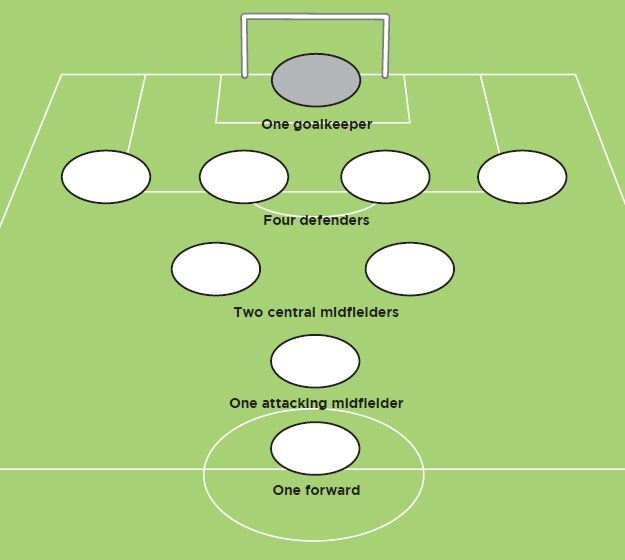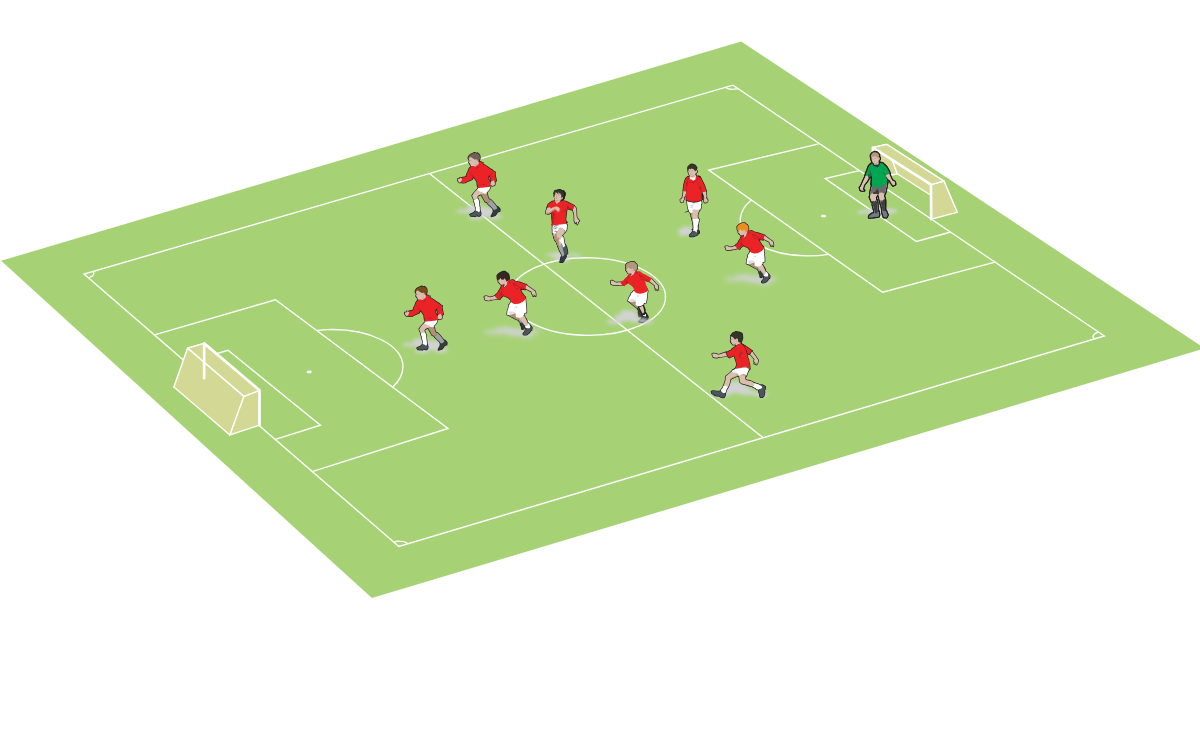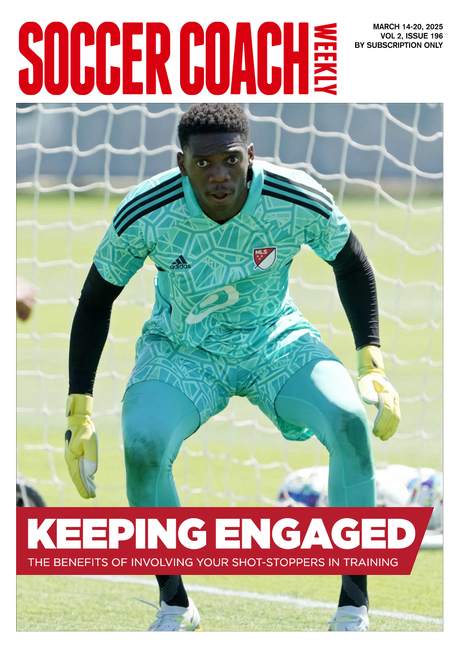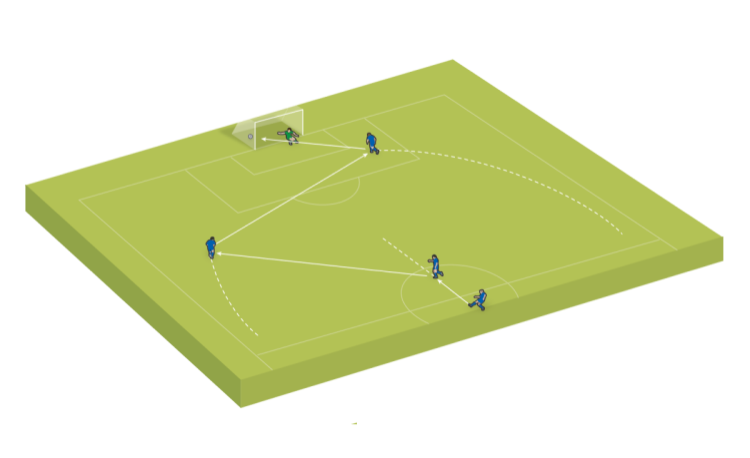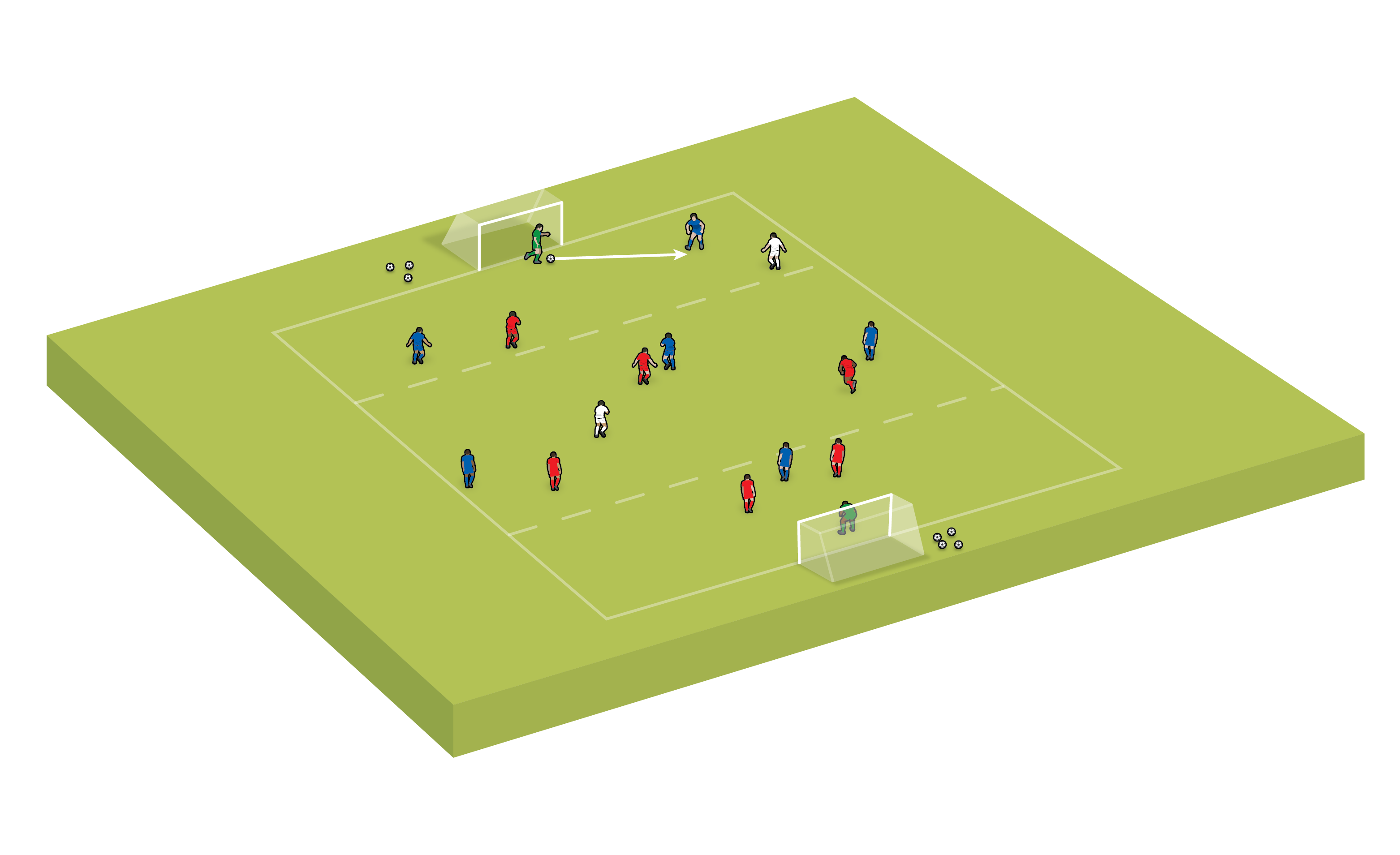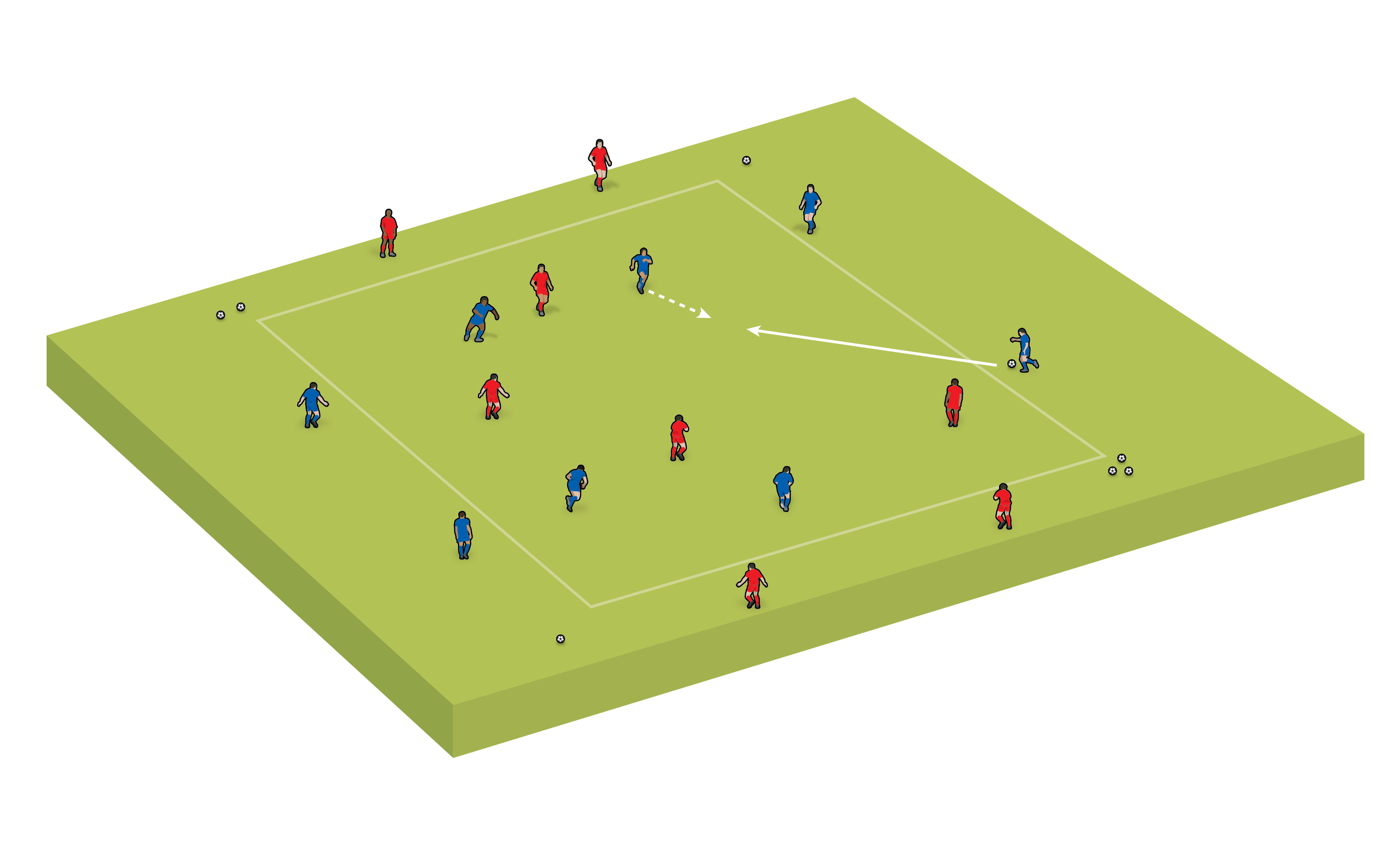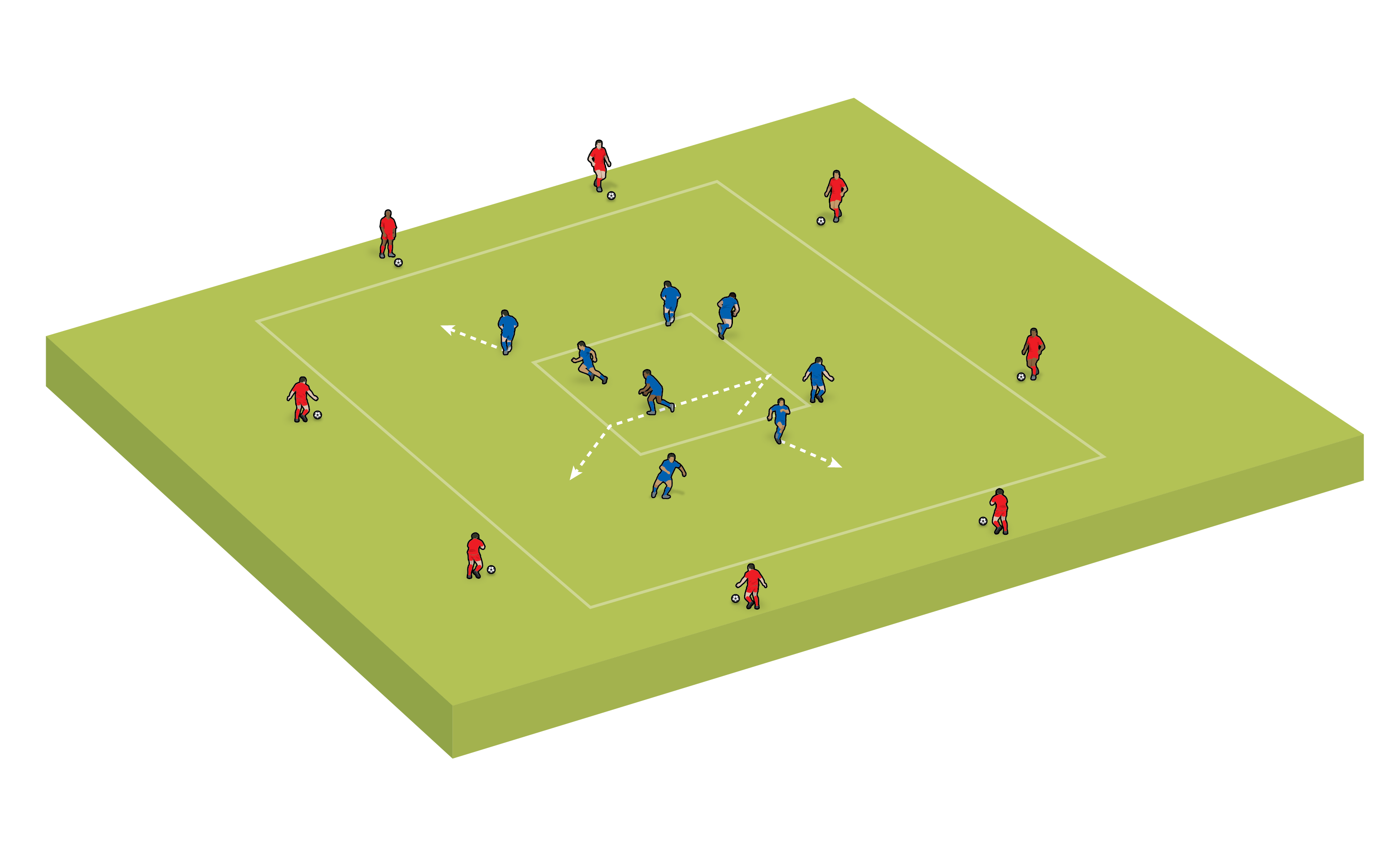9-a-side formation: 4-2-1-1
Why choose this 9v9 formation? Review the pros and cons, in possession and out of possession principles, and each position
Progresses from: 2-2-2 (7-a-side)
Progresses to: 4-3-2-1 (11-a-side)
PROS OF THIS FORMATION |
CONS OF THIS FORMATION |
|
|
|
|
|
9v9 4-2-1-1 - IN-POSSESSION SUMMARY
IN-POSSESSION PROS |
IN-POSSESSION CONS |
|
|
|
|
4-2-1-1 IN-POSSESSION – BY POSITION
Goalkeeper
There are two main elements of the goalkeepers’ performance that are developed within this formation.
As there are four players in the defensive unit, it is likely that the team will play across the field – in other words, they will look to switch the play.
When the ball is switched from one side of the field to the other, it is likely that the goalkeeper will be involved. They will, therefore, need to work on their positioning, body shape and the technique of playing a driven, diagonal pass.
In terms of their positioning, the goalkeeper will need to continually analyse where on the pitch they need to be so that they can receive the ball, should their team-mate want to play it back. A good first touch is also essential to set themselves up to make the next pass.
The other type of pass they are likely to play is the forward central pass into one of the central midfielders.
The full-backs positioned high and wide, and the two centre-backs ’splitting’, will provide big spaces centrally for the ball to be played to one of these midfielders.
This pass moves the ball into a dangerous area of the pitch where the opposition will look to try to win it.
The accuracy and weight of the pass will, therefore, be essential, to allow their team-mate to receive the ball and then protect it from any opponent putting them under pressure.
To do this, the goalkeeper will need to consider key factors, including on which side their team-mate wants to receive the ball, and the positioning of any opposition players in that area of the field.
Central defenders
The main involvement the two central defenders will have is within the build-up, either receiving the ball from the goalkeeper, or from an outfield team-mate playing it back to them.
When the ball comes from the goalkeeper, the defender will often not be under any immediate pressure, either because it is from a goal kick, or the ball is being switched from one side of the field to the other. Therefore, they should adopt the correct body shape and receive on the back foot, allowing them to play forward.
After receiving the ball, they will likely start to come under pressure, and will have a decision to make: Do they pass the ball to a team-mate? Or do they travel with it?
If they decide to keep the ball and drive with it, an opponent will press them and try to win the ball. Therefore, while travelling with the ball, it is essential that they are able to identify who, specifically, is closing them down.
Once they have done this, they can then look to change direction, if possible, in order to get their body between the ball and the player closing them down.
Full-backs
The full-backs will be key to their team when in possession, with two specific requirements.
The first is to help the team’s build-up and progress the play forward. To do this, they will need to consider their body shape and how they will receive the ball, so that they can play forward quickly when they are able to.
They must also think about positioning, in terms of distance and angle in relation to the player with the ball.
Once the team is in a position to play into the final third, the full-backs should operate more as wingers, to give options in the wide areas of the pitch.
As this formation has two central defenders and two central midfielders, the full-backs will have more confidence to move into these high positions, as they know there will be defensive cover in place should the team lose the ball.
Once they are positioned higher up the pitch, and in possession of the ball, the full-backs will then need to execute a number of different skills and techniques. The main one of these is crossing in a number of different ways, including driven crosses and cut-backs.
By staying wide, and coming from a deeper area, it is likely that, a lot of the time, the full-back will not need to beat a player, but instead deliver a cross before they are closed down.
This will require a good first touch, which will dictate what they do next and how effectively they do it.
For instance, a strong touch inside will allow them to drive towards goal, and then cut the ball back or drive it across the goal.
Central midfielders
With a lot of emphasis on the full-backs to provide the width, and the centre-backs releasing the ball quickly, to avoid getting caught in possession in a dangerous area of the pitch, it will likely to fall on the two central midfielders to keep hold of the ball.
This may involve them receiving the ball from a team-mate, such as a centre-back, and keeping it until the full-backs are able to provide a wide option; or, keeping hold of it until they are in a position to progress the ball to the attacking midfielder or the forward.
With the opposition likely to have the same number of central midfielders, or more, these two players are likely to come under a lot of pressure when on the ball. They will need to be able to receive it while under pressure, and then protect it while considering their next move.
If they choose to play to the attacking midfielder or the forward, they must use agility and some deception to turn their marker.
Overall, this position will support players to develop a range of physical attributes, including strength, agility and balance, alongside the technical ability to receive the ball, keep it under close control, and then manipulate it to get away from danger and, if needed, change direction.
Attacking midfielder
A key role in this formation, the attacking midfielder will need to have really good game intelligence, recognising where they are needed and, when necessary, how to find or create space for themselves.
They must provide an option for the central midfielders, who will often be under a lot of pressure when in possession. To do so, they must identify or create space.
Often, the striker staying high and stretching the opposition will leave space for the attacking midfielder to move into – they must then select the best position within this space, identifying where the player on the ball needs them and where will allow them to best complete their next action.
When they are looking for space, it is important that they do not move into it too quickly. If they do, an opponent will see them and follow them into this area of the pitch, closing off the space.
By delaying their movement, they can then enter the space at the same time as, or just before, the ball arrives. This will allow them to receive in space and play forward.
The other option is standing still and waiting for the space to open up in the area of the pitch they are positioned in.
Forward
One of their main requirements will be to make forward runs to stretch the opposition, producing spaces vertically for team-mates.
The main purpose of these runs is to allow a team-mate to either stay on the ball, creating space for them to travel into with the ball; or, for another player to use the space to receive a pass.
Sometimes, they can make this type of run to receive the ball themselves. In this instance, more consideration needs to be made about the timing and the area of run.
Players in this position can develop their understanding of how to curve or arch their run, so that they remain onside and can be on the move as the pass is made, rather than setting off from a standing start.
Holding the ball up is another important aspect of this role. In this formation, the team might have difficulty retaining possession once they have managed to win it back.
One way to try to maintain possession is by playing directly into the striker, who will then be required to keep hold of the ball while they wait for support.
This requires shielding the ball effectively, using the correct body shape and technique, along with the necessary strength to hold off the opponent.
It is then important that they select the right pass and play the ball into the correct area for their team-mate – ahead of them, so they can collect it and continue travelling forward; or into their feet, if they want to have more controlled possession.
4-2-1-1 – OUT-OF-POSSESSION SUMMARY
Related Files
OUT-OF-POSSESSION PROS |
OUT-OF-POSSESSION CONS |
|
|
|
|
|
4-2-1-1 OUT-OF-POSSESSION - BY POSITION
Goalkeeper
When the team is organised, and everyone is in the correct position, this formation is hard to break down.
The main danger for the goalkeeper will, therefore, come through counter-attacks, when the team is less structured.
Often, when an opposition team counter-attacks, they will have an overload, resulting in a player being put through on goal.
The goalkeeper will need to develop their one-on-one abilities, including the speed at which they close the attacking player down, and getting their angles right to make the goal as small as possible.
In this formation, the full-backs are expected to provide width in possession. But if that attack breaks down, and they are left high up the pitch, the opposition can counter-attack through the channels, due to the space that is available behind the full-backs.
This means that low, driven crosses, played across the penalty area, are a likely scenario for the goalkeeper to face.
Positioning is key in this situation, as is the decision-making process the goalkeeper needs to go through.
Placing themselves in the correct position will mean they can protect the front post, while also giving themselves the chance to intercept the cross.
In order to intercept, the goalkeeper needs to get down quickly, and either collect the ball cleanly, or clear it away from the danger area.
If they are unable to get to the cross, or decide not to go for it, the next action will be to block any shots that come from the cross.
Because these attempts on the goal are likely to be one-touch finishes, the goalkeeper needs quick feet to get into the right position, and quick reactions to block the close-range shot.
Central defenders
When the team is organised and set defensively, the two centre-backs will have lots of protection around them, meaning their main roles will be to make clearances and help keep the team organised.
The real challenge comes when the opposition is counter-attacking and they are required to defend while outnumbered.
How the counter-attack materialises will affect how these two players need to defend.
If they are facing a player driving forward with the ball, and there is a number of their team-mates providing supporting runs, the central defenders must be the ones that dictate the play.
To do this, they need to position themselves correctly and demonstrate the right body shape in order to force the player on the ball into the area of the pitch they want them to go into, and prevent them passing to a team-mate; specifically, preventing a forward pass. Doing so will help delay the counter-attack and allow some of their own defensive team-mates to recover.
In another situation, the ball could be played into space for a player to run on to.
If this happens, the central defender needs to establish the movement of the opposing player, and track their run to ensure they get themselves between the ball and the goal.
Once they have done this, they need to keep forcing their opponent away from the goal, by adopting the correct position, using their strength and being determined in their defending.
Full-backs
There are two completely different demands to this role, depending on whether the team is organised or out of shape.
When the team is organised, the full-back’s main roles are to help the backline stay compact, and to make the right decision as to when to press the ball.
In terms of helping the defensive unit remain compact, each full-back needs to work with the centre-back next to them, ensuring the gap between them does not get too large.
Body shape is key, especially when the ball is on the opposite side of the pitch.
The full-back must be able to see the ball, their centre-back partner, and any opposition players behind them.
The temptation is often to go and mark their opponent, but doing so will create gaps in more dangerous areas of the pitch.
The full-back actually needs to stay with their unit, until the opponent in the wide area has the ball and becomes a real danger.
When the team is out of shape, the full-back must identify the danger and make recovery runs.
It is important that, when recovering, they do not just run back to their position. They need to identify, specifically, where to go, spotting the gaps on the pitch and filling the ones that pose the biggest danger.
To help them with this, we can provide them with a guide, asking them to run towards the post furthest away from them, until they get into a position where they are alongside the deepest team-mate.
The player will, therefore, head towards the centre of the pitch, positioning themselves to protect the goal.
Central midfielders
These two players will spend a lot of their time shielding or protecting the backline.
For this, positioning is key. They need to try to stop the opposition from penetrating them and getting the ball into their front players.
To do so, they must position themselves in the opponent’s passing lanes – that is, where the player in possession wants to play the ball to get it to a team-mate higher up the pitch.
Body position is also important – the central midfielder needs to see the player on the ball, as well as the player behind them who is looking to receive it.
They will also need to decide when to press the player with the ball and when to hold their position.
The other important role they will play is to try to stop the opposition from counter-attacking.
When their team is in possession, the central midfielders should already be identifying danger: such as the possibility that a team-mate is about to lose the ball through being tackled, or by playing a pass that is intercepted.
When this does occur, the midfielders need to react quickly and get to the opponent on the ball, preventing them from starting the counter-attack.
To do this, they must develop their game understanding, so that they can start to predict what is going to happen, rather than reacting to what just happened.
They also need to understand that they do not always have to win the ball, they just have to do enough to slow the opponents down.
Attacking midfielder
When the team does not have the ball, the attacking midfielder will need to help the team to defend.
It is quite easy for this player to stay high up the pitch, considering themselves solely an attacking player.
But, as this formation has just two central midfielders, they will get overrun if the attacking midfielder does not drop into the space to support the defensive efforts.
By doing so, they essentially become a third midfielder, making the centre of the pitch a lot more compact and congested.
The way the opposition set up will have an impact on how the attacking midfielder can help their team defensively.
If the opposition is playing with a holding midfielder within a three-player midfield – as in a 3-3-2 or 3-1-2-1-1 formation, for example – the attacking midfielder could be given a specific defensive role.
Quite often, teams will use their holding midfielder during build-up play and, further up the pitch, to recycle or switch the play. Therefore, your attacking midfielder can be asked to mark the player specifically.
This is a great opportunity for them to work on their concentration levels and their decision-making, in terms of recognising when to sit tight and put pressure on their opponent, and when to try and intercept the pass or steal the ball.
Forward
This player will lead from the front when it comes to defending.
They could be asked to press the backline, and attempt to force the player in possession into playing into a specific area of the pitch. Or, as they are on their own, they could be asked to drop back and help the team defend in a ‘block’, rather than a press.
When doing this, the striker will need to go from working hard and putting lots of pressure on the player who has the ball, to demonstrating a more disciplined and patient form of defending.
They need to understand that they cannot go chasing the ball or be tempted to try to win it.
If they press, and the rest of the team remains where they are, the opposition will find it easier to progress forward and potentially play through the block.
However, that does not mean the forward should never press the ball; rather, they need to learn when the time is right to press. Their team-mates will then be able to learn that when the striker goes to press, everyone else should also press.
The decision-making from the forward then becomes even more important.
In order to make the best decisions, they must recognise the triggers to press, such as a poor touch or a pass backwards, and also ensure they have team-mates who are close enough and can press with them.
Newsletter Sign Up
Coaches Testimonials

Gerald Kearney, Downtown Las Vegas Soccer Club

Paul Butler, Florida, USA

Rick Shields, Springboro, USA

Tony Green, Pierrefonds Titans, Quebec, Canada
Subscribe Today
Discover the simple way to become a more effective, more successful soccer coach
In a recent survey 89% of subscribers said Soccer Coach Weekly makes them more confident, 91% said Soccer Coach Weekly makes them a more effective coach and 93% said Soccer Coach Weekly makes them more inspired.
*includes 3 coaching manuals
Get Weekly Inspiration
All the latest techniques and approaches
Soccer Coach Weekly offers proven and easy to use soccer drills, coaching sessions, practice plans, small-sided games, warm-ups, training tips and advice.
We've been at the cutting edge of soccer coaching since we launched in 2007, creating resources for the grassroots youth coach, following best practice from around the world and insights from the professional game.
